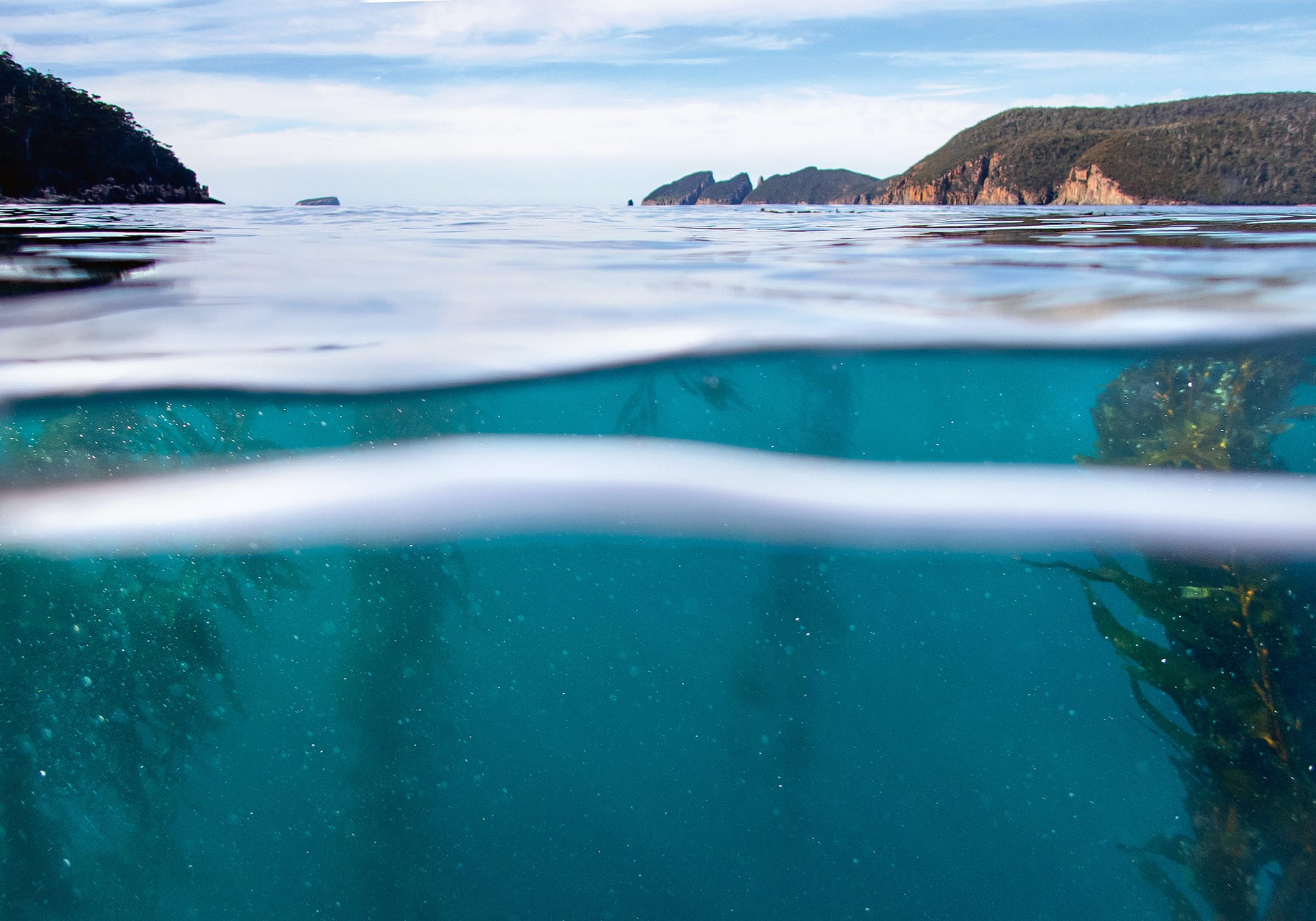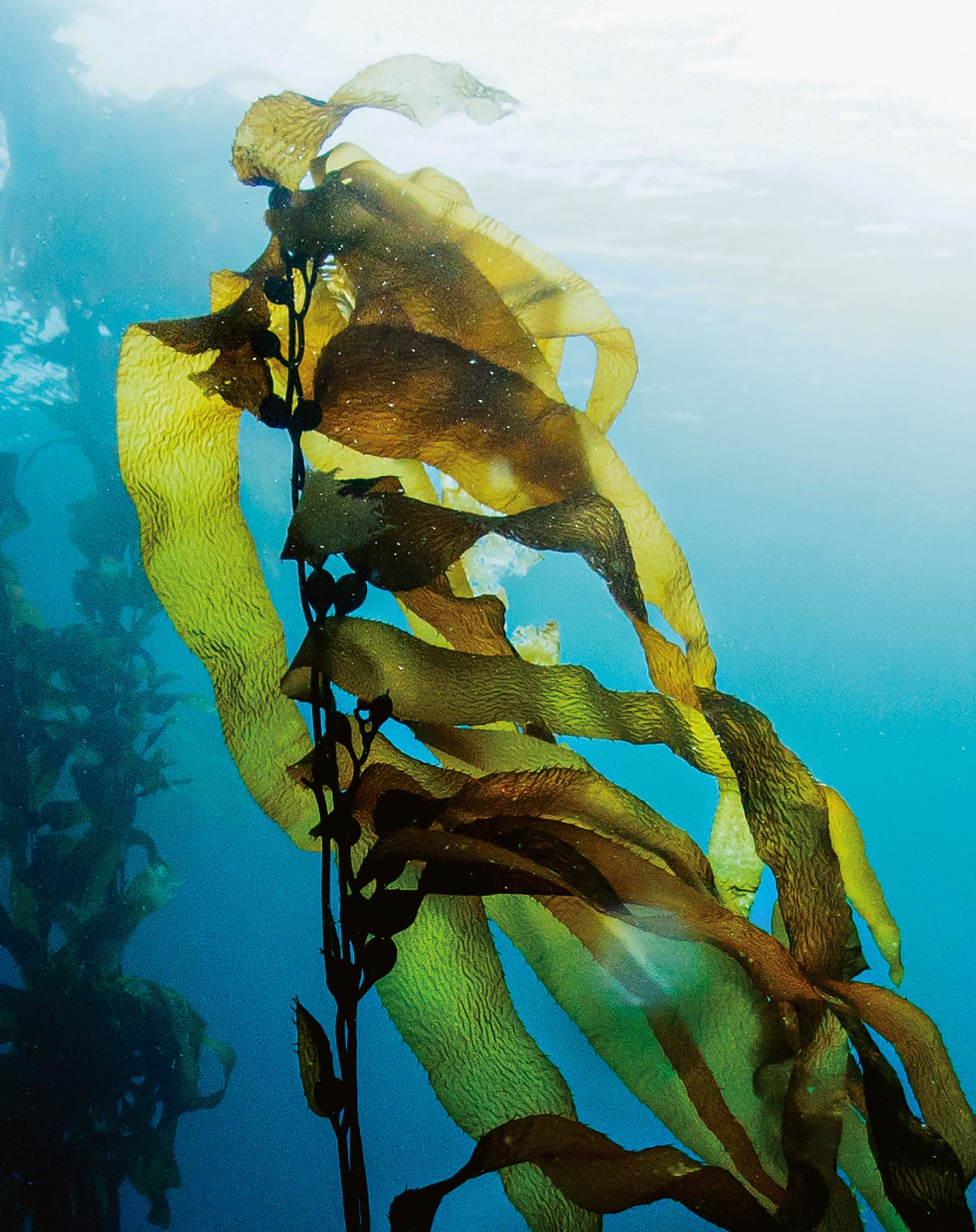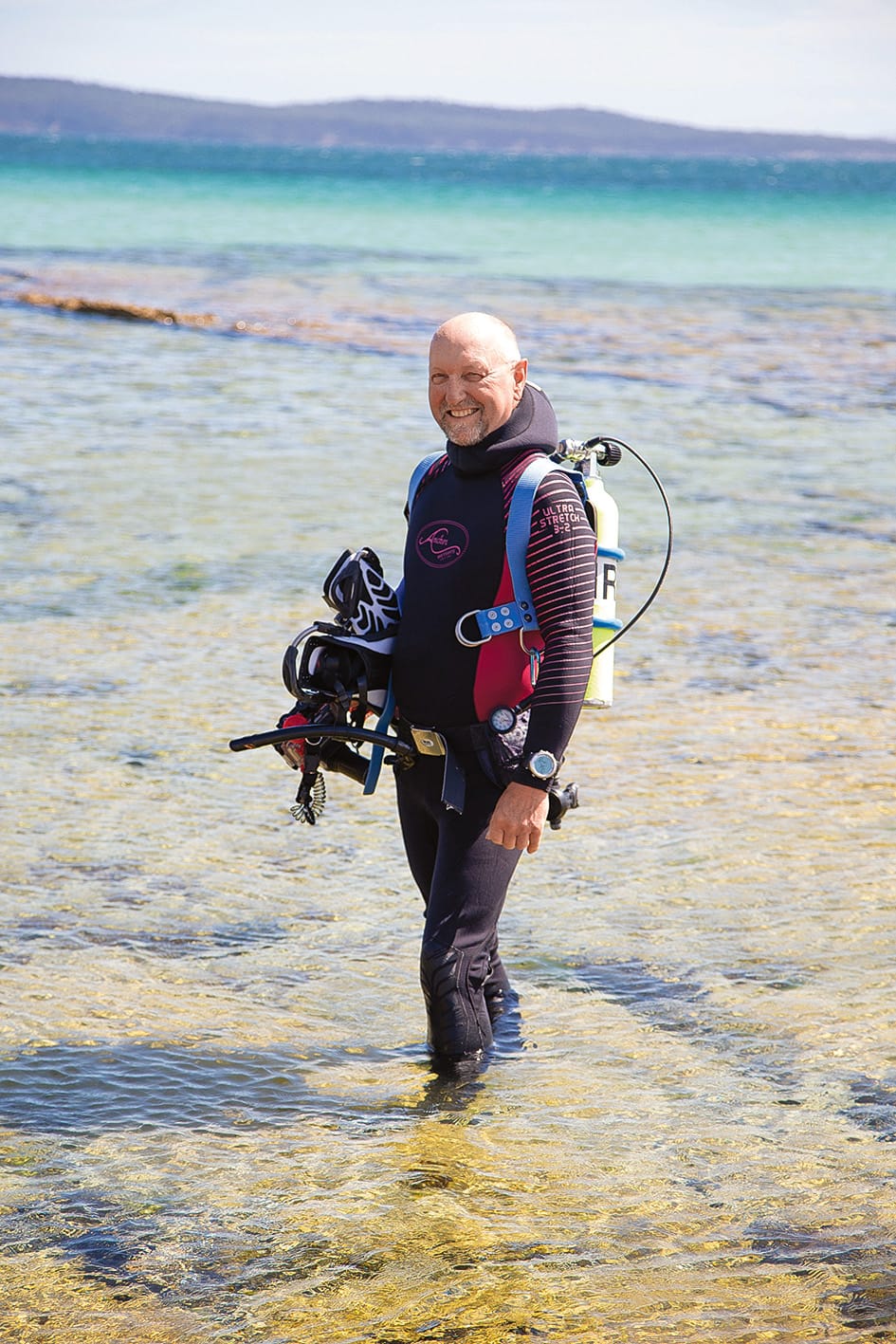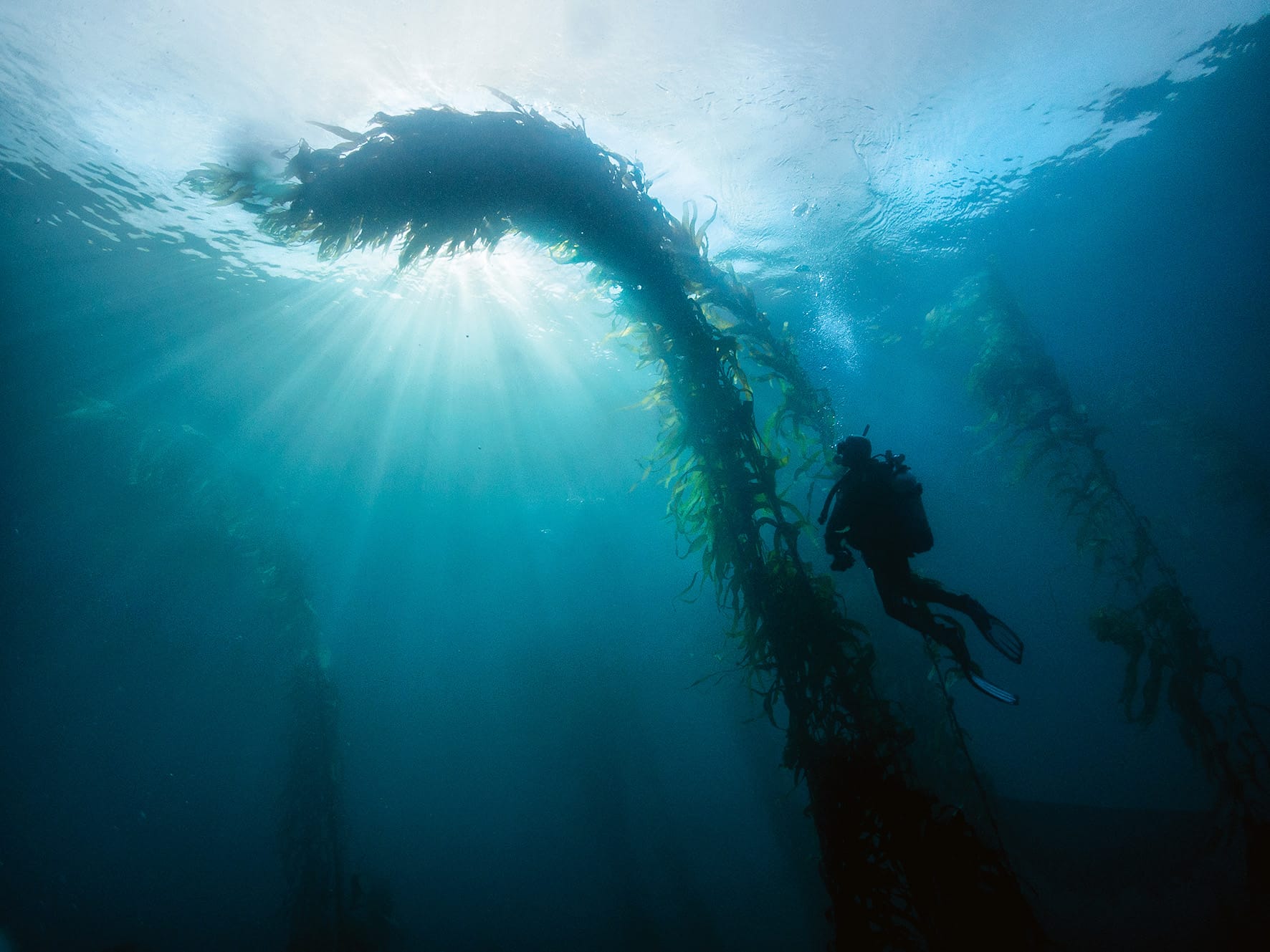
Simon Brooks pulls on a wetsuit to garden. In freezing waters, he’s saving the endangered forests of giant kelp off the southern Tasmanian coast.
Words Meg Bignell
Photography Alice Bennett
THE forests of giant kelp and bull kelp off the Tasmanian coast carry an almost preternatural energy that can soften the toughest of old salts. Fishermen, shackies, boaters and divers fondly remember kelp forests as everyday features of coastal life, childhood adventures, places of calm.
For the palawa, the Tasmanian Aboriginal people, kelp forests are used as food sources and to make water carriers. The kelp’s tiny residents, known as maireeners, or rainbow kelp shells, are also used in shell necklaces, among the oldest continuing cultural practices in lutruwita/Tasmania.
For others, they can become a lifelong passion. “It’s hard to describe the wonder of the kelp forests,” says Simon Brooks, as we drive to an area of diverse marine plant life off the Tasman Peninsula in south‑east Tasmania. “They are beautiful to look at but it’s also about the aquaculture community they foster. And being underwater is a tonic. It’s the tingling on the skin, the refreshment ... we all like to get out in nature but down there it’s complete sensory, natural immersion.”
Brooks started scuba diving off the east coast of England when he was a boy. He came from a family of divers, in a district fabled for its shipwrecks and maritime mysteries. He worked as an assistant to his father at scuba training nights until he could fit into a wetsuit – this was the North Sea, after all. And when Brooks’s wetsuit turned out to be too big, his dad gave him a woolly jumper to pop on underneath and off they went into the chilly deep.

About a decade after his first dive, Brooks found himself captivated by a Jacques Cousteau film about the Great Barrier Reef. At the age of 21 he left England for Port Douglas in far north Queensland, bought himself a $1000 trawler and spent 15 years realising his reef dreams.
“The wet seasons were unbelievably hot for an Englishman,” he recalls. “And I had no air-conditioning. Eventually the heat got the better of me and I went looking for some cooler air.”
Brooks ended up in Tasmania, where the cool, nutrient-rich waters introduced him to one of the Earth’s most diverse marine plant populations. The island has more than 650 recorded marine plants belonging to several groups, including macroalgae (seaweeds), blue-green algae, seagrasses, lichens and fungi. Biologically these groups are not closely related, but they all thrive in salt water at low tide levels or sub-tidally on rocks. Occasionally they attach to other plants or even animals, and a rare few are free-floating.
“It’s hard to describe the wonder of the kelp forests. They are beautiful to look at but it’s also about the aquaculture community they foster.”
All these species need light to make their own food, which means they grow only in shallow waters, generally up to about 25 metres. These plants are the ocean’s primary producers, utterly indispensable citizens of the underwater world. They release oxygen, absorb carbon, provide food for the herbivores of the deep, form nursery grounds for sea creatures, support fisheries and enhance ecotourism.
Among the macroalgae group is the brown algae subset, which incorporates the phenomenonal Macrocystis pyrifera, or giant kelp. This is the marine plant best known for its formation of magnificent kelp forests, some up to 30 metres tall. These forests feature a canopy at the surface that softens the light and hosts an understorey of other marine species.

All kelps, including giant kelp, have holdfasts, blades and stipes instead of roots, leaves and stems. The holdfast anchors the kelp against the surge and tug of waves and tides. Giant kelp has branched holdfasts, like little claws, which need substrates to attach to, most commonly stones or rocks. The stipes of giant kelp feature little football-shaped bladders that act as floaties for the massive fronds.
The blades (the leaf-like part) are broad and serrated to help with nutrient mixing. All kelps rely on the movement of water for a steady supply of nutrients necessary for photosynthesis and growth. They have a constant symbiotic relationship with many other species, including colonies of tiny, nutrient-gathering bryozoans, which to us appear as white calcium deposits on the stipes and blades, but under a microscope look like delicate, exotic flowers. Within a harmonised community and under healthy conditions, giant kelp can grow up to 60 centimetres a day.
“Those crucial holdfasts protect worlds within worlds within worlds,” Brooks says. “The further in we look, the more life we see.”


Simon Brooks scuba diving in the kelp forest. Photograph Alice Bennett.
When we visit Brooks’s home at Boomer Bay near the Tasman Peninsula, we find that his ocean immersion doesn’t stop when he leaves the water. The house, converted from a boat shed after his actual house burnt down in the 2013 Dunalley fires, is glass-fronted and open to the immediate shoreline and sea views.
Inside, the walls are painted aquamarine. He lives between racks of wetsuits, life jackets, fins, ukuleles and his art studio, where he presses seaweed and paints their likeness. On the coffee table in the sitting room is a microscope, which he uses to view the organisms that inspire his art. The television is draped with seaweed pictures.
Brooks is not just a master diver or an enthusiast, not just a citizen scientist, conservationist, thalassophile or naturalist. He is all these things, but mostly he is a doer, a man of action. And now, more than anything, the kelp forests need people of action.

During the past 20 years, 95 per cent of Tasmania’s giant kelp forests have disappeared. Some say it is too late to list them as critically endangered; they are too close to extinction. Scientists attribute this dramatic loss to the increasing incursion of the warm, nutrient-poor Eastern Australian Current. The worst of the damage is on the east coast. To add insult to terrible injury, the current has brought with it invasive sea urchins that feed on kelp and seaweed and form huge “urchin barrens” where the forests used to be.
Overfishing of the urchin’s primary predator, the southern rock lobster (universally known as crayfish by Tasmanians) has exacerbated the problem, as has recent El Niño weather patterns, which have brought extreme drought and eliminated the pulse of nutrients that comes from land runoff. In short, conditions have formed a perfect, catastrophic storm and deprived kelp forests of the conditions they need to thrive.
In the past five years the Eaglehawk Dive Centre, located at the gateway to the peninsula, and the non-profit organisation SeaCare have been developing a giant kelp habitat restoration and propagation program. Giant kelp propagation takes commitment, expertise and patience.
Brooks and others dive several times a week, year-round, doing horticulturally complex work: spore propagation and release, seeding, placement into natural ecosystems, monitoring plant progress, removing pests. They must harvest male and female reproductive blades (leaves) from the lower parts of the plant, take them into controlled conditions and wash them clean of contaminates or other species. Once that’s done, the blades are put into a fridge to induce stress, then placed in sterilised water along with lengths of fine rope, where they release their spores. The male and female spores find one another and seed onto the rope.
For six weeks the spores are kept in an environment with optimum conditions until they are large enough to begin forming a holdfast. At this stage the rope, with its host of baby kelps, is wrapped around a suitable substrate (in most cases a house brick), tagged and transported to trial sites in waters deemed most favourable for plant growth.
These propagated specimens are now dotted around various coastlines, providing vital information about kelp survival, algal adaptation, changing ocean conditions and ecosystem impacts. In some test sites, the SeaCare gardens are growing well. They might one day turn into forests that fortify the underwater community, answer more questions, attract more conversation and build a legion of marine plant warriors.
“We’re doing the regeneration work,” says Brooks, “but we’re also trying to spark more conversation, educate people, recruit more volunteers, and just ask people to stick their head underwater and see for themselves just how invigorating and glorious it is; adopt a bay, get a good wetsuit, a mask and some fins, join the underwater movement.”
There’s been a marine regime shift, he says. “We need to change our thinking accordingly as we plan our next steps. The coastal bays and estuaries are a barometer of what changing weather patterns can do. They are writing us a story and it’s up to us to read it.”
This is an edited extract from Tasmanian Gardens by Meg Bignell and Alice Bennett (Thames & Hudson Australia, $79.99). This is one of 20 stories of remarkable Tasmanian gardens and gardeners included in the book.
